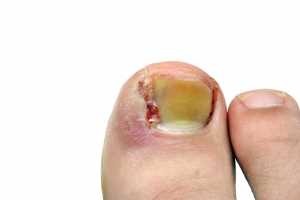As we get older the toe nails get thicker. It is a normal part of ageing. That is going to make the cutting of toenails all the more difficult as they are so thick. On top of that aging related thickness, trauma to a nail can also damage the growing area of the nail and cause the nail to become thicker. That trauma could be from years of wearing tighter shoes, a claw toe that puts pressure on the toenail or something like dropping a brick on the foot that damages the nail. Occasionally there is a skin condition associated with the thicker toenails.
Technically a thicker toenail that has no deformity is called onychauxis and if there is a deformity of the nail present, then it is called onychogryphosis. Onycho- means ‘nail’, so its a conditions of the nails.
Once the damage is done to the nail matrix or growing area of the nail in conditions like onychauxis, it is not possible to repair or fix that damage. The nail will always grow that way. If you can not manage to cut and look after the damaged toenail, that is where we come in. Using our tools and our skills we can reduce that problem nail or all of them if they are all affected. This is going to need to be done periodically as the nail will continue to grow back.
On occasion, especially of the toenail is causing a lot of problems it may be possible to remove the nail permanently and destroy the nail matrix so that it does not grow back.



